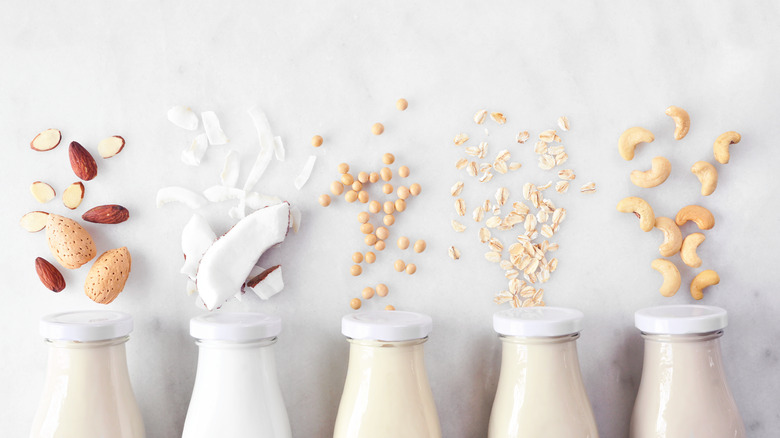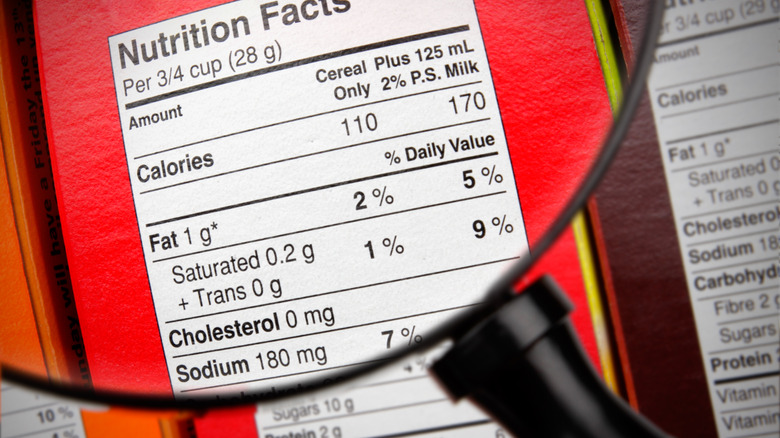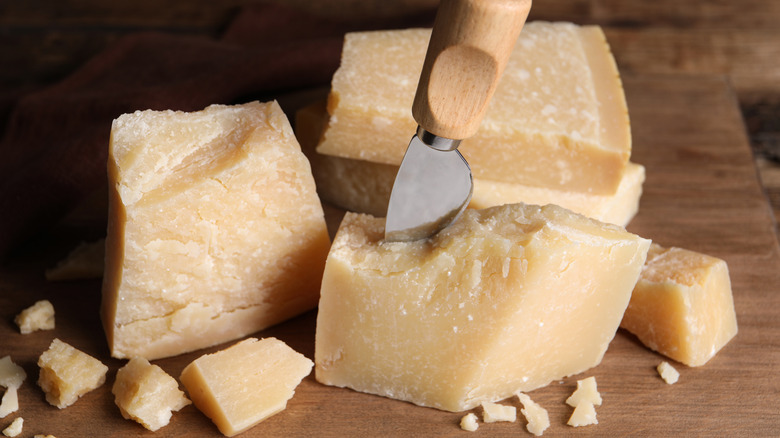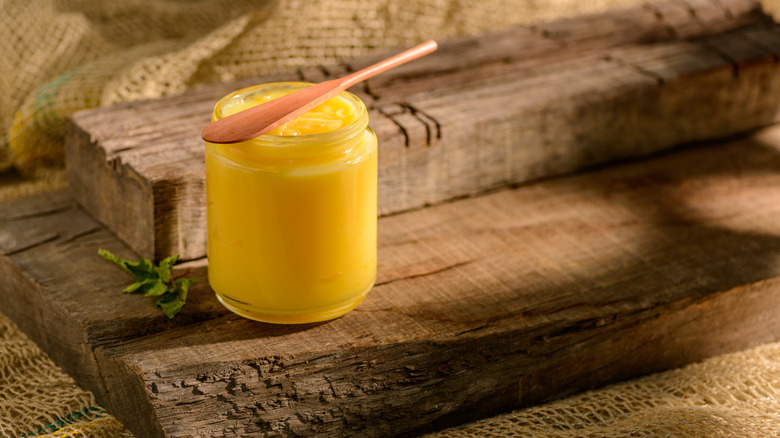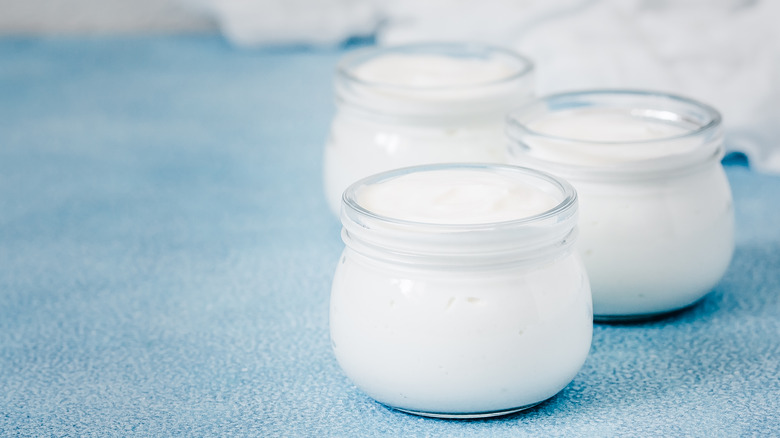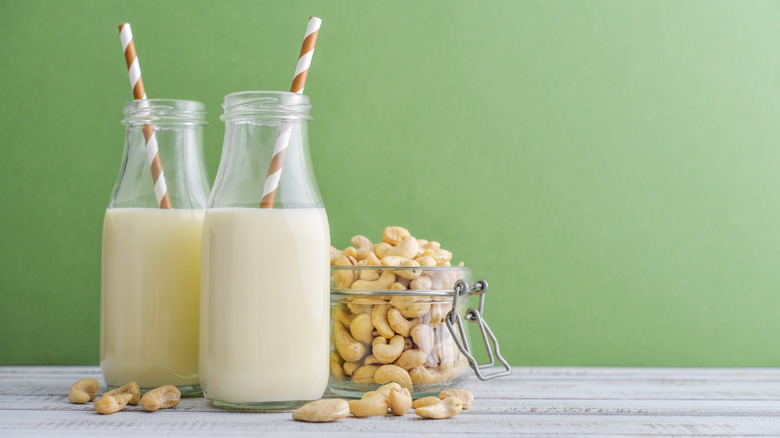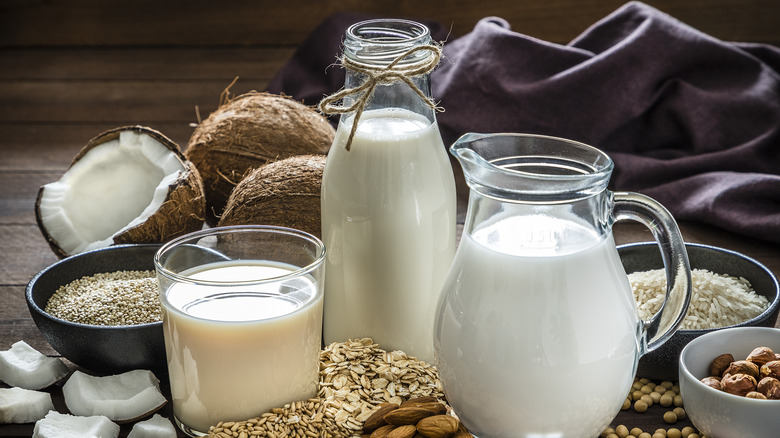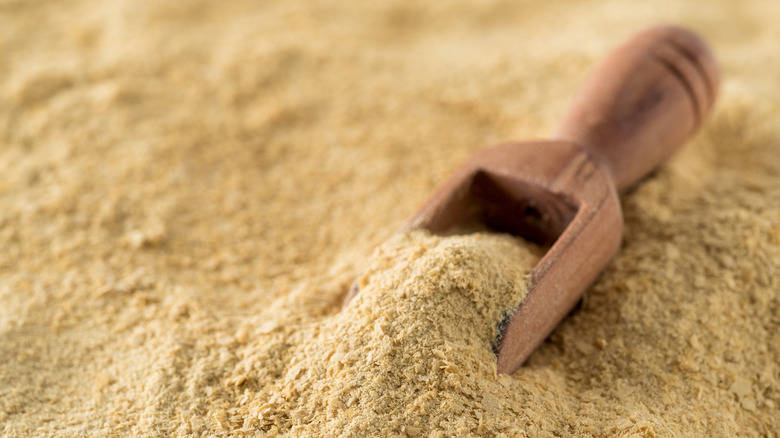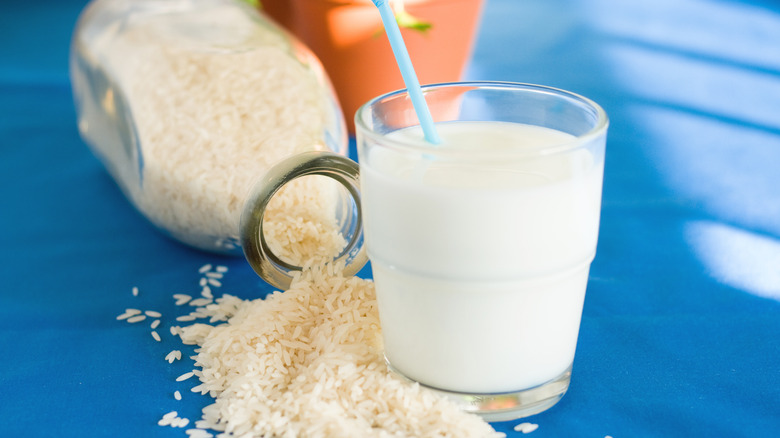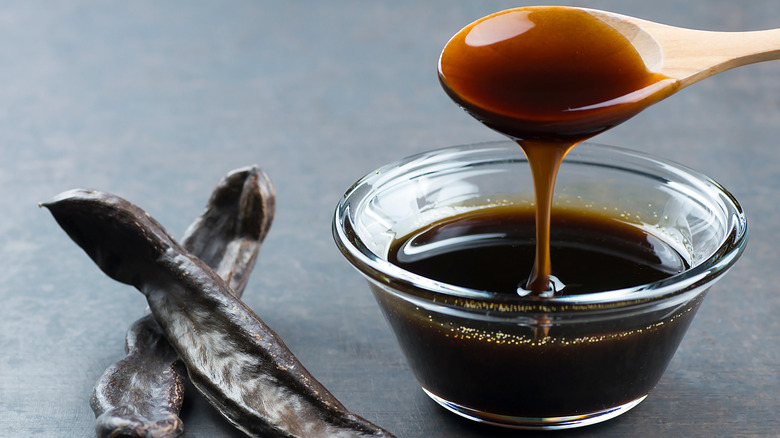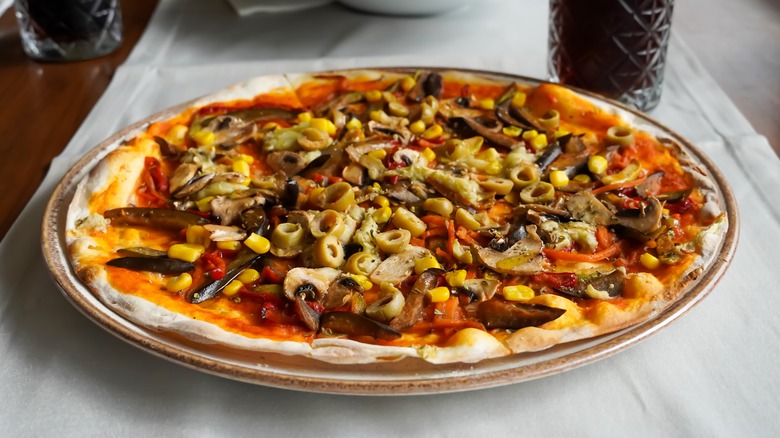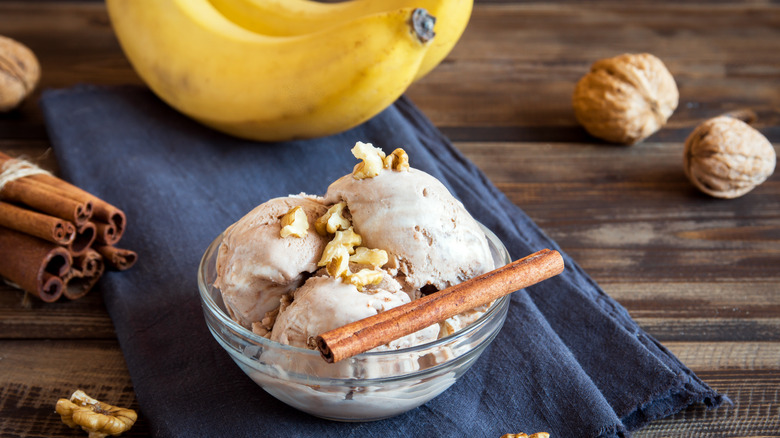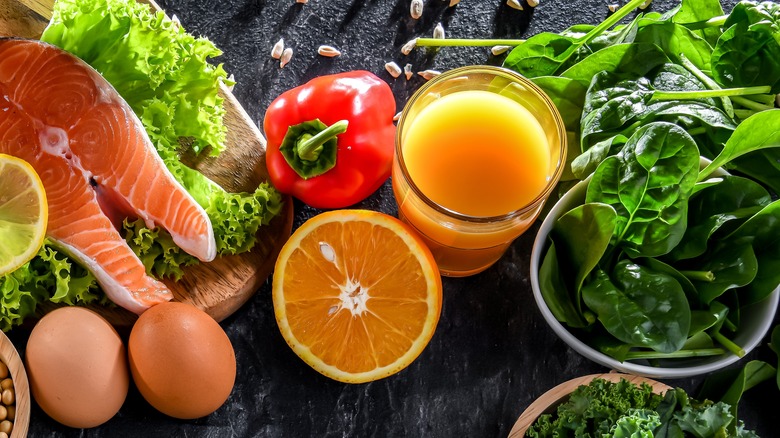The Ultimate Guide To Cooking Dairy-Free Like A Pro
According to resources from FARE, Food Allergy Research and Education, approximately 32 million Americans have food allergies. Of these, about 6.1 million are allergic to dairy, more specifically cow's milk, though many more, around 30 million by the age of 20 per WebMD, are lactose intolerant. Beyond this, even more individuals have chosen to avoid dairy for either medical, ethical, or religious reasons, making the need for education on how to eat dairy-free a necessity.
So much of our daily food consumption typically revolves around dairy, from our morning coffee to sauces to cheese on our pizza. It feels almost impossible to escape. And yet, for some, it can be a life or death situation if they inadvertently consume any. It can feel overwhelming to figure out how to adjust to a dairy-free diet in a world that seems dominated by it. Yet, some facts, tips, strategies, and tricks of the trade can help you adjust virtually any recipe, from soups to cakes, to be dairy-free. Let's look at how you can start cooking dairy-free like a pro.
Lactose versus casein
From a practical point of view, why someone opts to eat dairy-free doesn't matter. However, from a medical perspective, it does, particularly when adjusting to what you may or may not be able to incorporate into your daily routine. For this reason, it is necessary to understand the distinction between lactose intolerance versus a casein sensitivity or allergy.
Lactose is the sugar found in milk. To properly digest this sugar, the body manufactures a digestive enzyme known as lactase. When you do not produce enough lactase, undigested lactose can seep into your colon, where it will cause intestinal discomfort, according to WebMD. Casein is a protein in milk that can trigger an immune response when your body perceives a threat and attempts to neutralize it. While a casein sensitivity or allergy may have some gastrointestinal symptoms, it also can trigger reactions like hives, rashes, swelling of your lips or tongue, difficulty breathing, and potentially anaphylaxis. In other words, while lactose intolerance may be discomforting and make you feel quite ill, a casein allergy may be immediately life-threatening, according to Healthline.
On WebMD, it says that those with lactose intolerance can consume dairy in small amounts by using an enzyme supplement, like Lactaid, before eating dairy to help digest it. In contrast, those with a casein sensitivity or allergy should likely avoid dairy altogether. Again, this isn't intended to minimize the discomfort of either but to allow the consumer to make an informed decision as to how to adjust their dairy intake habits.
How to read labels
In 2006, the Food Allergen Labeling and Consumer Protection Act, FALCPA, went into effect, requiring that all of the top nine allergens be clearly disclosed on food labels, including milk. Also known as the plain language labeling law, the labeling should be easy enough to read so that even a child can decipher whether or not it is safe to eat if they are allergic to dairy. Unfortunately, while this labeling has helped, it is not always a foolproof method to avoid consuming dairy.
Food labels with known allergens must include disclaimers, such as contains: milk. This should also be reflected in the ingredients list, where the allergen is denoted after the item, for example, whey protein concentrate (milk). Many labels will also include voluntary statements regarding the potential for cross-contamination during manufacturing. These include phrases like; may contain; made in a facility with; and produced on a shared line with. While these are helpful, they are not mandated, so there is no guarantee of accuracy.
To further complicate matters, some ingredients contain words that may insinuate the presence of dairy, like calcium or butter, when they do not. In other cases, components that may seem safe can contain dairy, like; artificial or natural flavors and flavoring; or fat replacers. It may be prudent to keep a handy list of dairy ingredients with you and to familiarize yourself with some of the most common culprits to help you quickly and easily spot a suspicious item.
Why goat milk products may be safe
Whether or not you can consume goat milk if you are lactose intolerant or have a casein sensitivity or allergy is complicated and highly individualistic. Like cow milk, goat milk does contain lactose, albeit in slightly lower quantities. Goat milk has about 4.20% lactose versus 5% for cow milk. This may seem insignificant, but depending on your degree of sensitivity, it can make a big difference in your capacity to digest small amounts of goat milk. In fact, some studies have even indicated that for mild lactose intolerance, consuming small quantities of goat milk can positively impact gastrointestinal symptoms, according to Healthline. This has been attributed to goat milk having smaller fat molecules than cow milk, which is easier for someone with a compromised digestive system to process.
For casein sensitivities and allergies, the subject may be even more complex. Though casein is the primary protein in goat milk and cow milk, some individuals can seem to tolerate it. The International Milk Genomics Consortium states that cow milk is higher in alphaS1-casein, while goat milk is higher in beta-casein. There appears to be some correlation between the alphaS1-casein and more severe allergic reactions, which may make goat milk tolerable to some. Additionally, levels of alphaS1-casein versus beta-casein can vary from one goat breed to another, further muddying the waters. The bottom line: Check with your medical professional before you delve into goat milk. However, it may be worthwhile to investigate it as a nutritional supplement if you cannot tolerate cow milk.
Why hard aged cheeses may be safe
When it comes to the topic of cheese, we are not discussing those who have a casein sensitivity or allergy, but rather those with lactose intolerance. According to Healthline, those with lactose intolerance can consume up to 12 grams of lactose per day, or the equivalent of one cup of milk, as long as it is staggered throughout the day. This is highly individualistic and may not be possible for those with severe sensitivities. That said, if you seem able to eat a small quantity of dairy without discomfort, you may be able to incorporate lower-lactose food items. One of these is hard-aged cheeses, like parmesan, swiss, or cheddar.
The process of cheese production is partly to thank for this. After incorporating rennet or acid into milk, milk curds naturally separate from the whey. When the whey is drained off, much of the lactose in milk gets discarded with it. As cheese ages, the bacteria within the cheese will continue to consume any remaining lactose. The longer cheese ages, the more lactose will have gotten consumed, leaving behind only minuscule amounts. This is even more true for cheeses made using goat's milk, like pecorino romano, which, as we have already noted, has less lactose than cow's milk. The bottom line: If you know you are not hyper-sensitive, you can test out incorporating small quantities of some hard-aged cheeses into your diet, especially where it counts, like a garnish for a pasta dish or a dairy-free pizza.
What are the best substitutes for butter?
When discussing substitutes for butter, one must consider the purpose of butter in a recipe. In cooking, butter is often used for flavor and to keep the proteins in food from adhering to the pan. Appropriate substitutes for this may include equal portions of coconut oil, lard, vegetable shortening, dairy-free margarine, nut butter, and plant oils. Nutritional yeast can be added to these fats to help supplement some richness in flavor.
When baking, things can get a little trickier. Butter in a baked good provides flavor and is integral to the texture of the baked good. Without it, your cookies, quickbreads, cakes, and muffins may become hockey pucks due to a lack of moisture and fat. Coconut oil, margarine, lard, and vegetable shortening would provide a similar texture to butter in a baked good. If you use oil instead of butter when baking, you will want to adjust the quantity to ¾ cup for every cup of butter. You can also incorporate ½ cup of fresh fruit purée mixed with a tablespoon or two of oil, like apples, pears, or bananas, for every cup of butter in a recipe, particularly in quickbreads or cakes.
And finally, though ghee is made from butter, once the butter is clarified, meaning the milk solids are removed from the fat, much of its lactose and casein gets removed. This means it can be quite well tolerated by lactose or casein-intolerant individuals, according to Medical News Today.
What are the best substitutes for sour cream or yogurt?
We decided to combine sour cream and yogurt here because they often get used interchangeably in cooking and baking. This is not the case if you eat yogurt with fruit for breakfast, but it applies even when garnishing tacos or baked potatoes. They both have a tart flavor and a creamy texture that can incorporate a luscious texture in recipes like soups and sauces. They also add acidity and moisture to baked goods, helping to leaven them and give them a more supple texture.
If the goal is to incorporate creaminess into a dish, coconut cream, cashew cream, and avocado cream can be great alternatives. Each of these can emulsify and thicken the way that sour cream or yogurt does, albeit with different flavors. You may need to play with them to decide which you prefer in your favorite recipes. Avocado, for example, may need to be combined with some almond milk to make it less vegetable-forward, especially if you are using it in baking. If you want to obtain a tart flavor in a recipe, vegan sour cream or yogurt might be a better substitute.
When baking, while any of these can get added, you will likely need to incorporate some acid into your recipe, such as lemon juice or apple cider vinegar. The ratio is for every cup of the sour cream or yogurt substitute you decide to use, add one tablespoon of lemon juice or vinegar. This will give you a slightly better texture in the finished product.
What are the best substitutes for cream?
When seeking cream substitutes, the flavor is a consideration here. For some things, you will want to opt for more neutral-flavored alternatives than others. Another consideration is the purpose of the cream. If trying to create a whipped cream substitute, you may have to opt for thicker substitutes. Many of these will require additional preparation, such as long refrigeration times, removing excess liquid, or adding a thickener to obtain the fluffy texture necessary to create a whipped cream facsimile.
Yet again, cashew cream and coconut cream are frontrunners because of their lovely nutty flavor. These can be used cup for cup to substitute cream in any recipe. Soy heavy whipping cream and Silk heavy whipping cream can also be used one-for-one in recipes but tend to have a slightly more aggressive flavor. These would be better options in baking, where sugar and other flavorings can balance out the flavors. Mixing ⅔ cup of soy milk with ½ cup of olive oil can be great for savory dishes, like soups, but we'd skip it for desserts. This can be used in a two-to-one ratio instead of cream. And finally, combine two tablespoons of cornstarch with one cup of non-dairy milk to create a solution that would work equally well in sweet or savory applications as a one-to-one substitute as long as the cornstarch is dissolved thoroughly. While recipes exist for cream substitutes made of dried beans, we would skip these due to their aggressive flavor.
How to make a dairy-free buttermilk substitute
Historically buttermilk was produced from the liquid that remained after churning cultured cream into butter. Today, buttermilk is fashioned by incorporating lactic acid bacteria into uncultured cream, which ferments it. Buttermilk is a common ingredient in baked goods because its acidity activates the leavener in a recipe, causing it to rise faster and more efficiently, which results in lighter, fluffier baked goods. And it is equally as valuable in marinades or sauces for its tangy flavor and capacity to break down dense protein strands in meat. Because the key to buttermilk is acid, any non-dairy substitute must have that acid in it to properly mimic buttermilk.
One solution is to incorporate 1½ teaspoons of cream of tartar into the dry ingredients of a recipe for every cup of dairy-free milk substitute. You can also add one tablespoon of lemon juice or apple cider vinegar to one cup of non-dairy milk substitute. While some recipes indicate using distilled vinegar for this, we think it is too acrid, so we stick to the apple cider variety. We typically allow this to sit for about ten minutes before adding it to our recipes. Yet another alternative is to incorporate ¼ cup of water into ¾ cup of dairy-free yogurt or sour cream. Finally, try blending ¼ cup of silken tofu with ¾ cup of water and one tablespoon of lemon juice or apple cider vinegar. While you can use other acidic beverages, like orange juice, these are not a substitute for buttermilk.
The best substitutes for cheese
Cheese is one of the things that some of us who have to be dairy-free miss the most. Not only does cheese impart an umami-rich flavor into recipes, but its capacity to melt also plays an integral role in the texture of some of our favorite foods. While we won't insinuate these alternatives will be exactly like cheese, they can provide some flavor and texture when one or more of them are used together. A quick note about dairy-free cheese substitutes. These can be effective and convincing as is on a sandwich but do not melt particularly well.
For flavor in recipes like sauces, casseroles, soups, baked goods, or sprinkled on salads, nutritional yeast, also known as nooch, can be just what the doctor ordered. Its yeast matured in molasses and water before being pasteurized and dehydrated. When finished, it behaves a lot like grated parmesan. Another alternative is to use vegetable dips and spreads, like hummus, dairy-free pesto, herb oils, tahini, guacamole, and puréed butternut squash or sweet potato. These can provide a creamy, slightly fatty layer allowing other ingredients to adhere to your pizza, quesadillas, or mock grilled cheese sandwiches. For a creamy and nutty treat, nut cheeses can be a satisfying addition to sauces, soups, casseroles, or any recipe that might call for ricotta, feta, goat, or cream cheese. And finally, tofu can be coaxed into having the texture of melted cheese in some recipes, even if its flavor can be a bit overwhelming.
What is the best milk alternative?
Finding a suitable non-dairy alternative to milk with a rich mouthfeel and pleasant creamy flavor can be challenging. Many non-dairy kinds of milk, particularly bean or legume-based ones, have an aggressive vegetable-forward taste potentially suitable for savory recipes but unpleasant in sweeter recipes. For this reason, we avoid soy milk and pea milk. In addition, soy has potential concerns regarding disrupting estrogen receptors in the body and causing gastrointestinal discomfort. We also tend to steer away from hemp and quinoa milk because they are harder to find and can have a bitter aftertaste.
Our favorite dairy-free milk substitutes tend to be in the nut family, such as almond, cashew, pistachio, and macadamia nuts, coconut milk, oat milk, and rice milk, which is typically the most easily tolerated by a wide swath of the population with multiple allergies. These have pleasant flavors that can complement both savory and sweet recipes. The only issue is texture, which can be supplemented with additives, such as carrageenan and other vegetable gums, to help give these kinds of milk a smoother and richer texture.
And finally, if you are not allergic to milk but are lactose-intolerant, lactose-free milk may be a great alternative. It is created by neutralizing lactose by adding lactase into the milk to break the lactose into simple sugars, glucose, and galactose, thereby rendering it easier to digest. Under this process, lactose-free milk is generally sweeter than regular milk, which may make it an acquired taste for some.
Best substitute for chocolate
The topic of chocolate can be confusing because chocolate in and of itself is dairy-free. Pure baking chocolate doesn't have added dairy, but dark, semi-sweet, milk, and white chocolates do. Additionally, many types of chocolate truffles, chips, and bars are produced on equipment that has come into contact with dairy, thereby causing cross-contamination, which may cause an allergic reaction in those with dairy allergies.
That said, there are several non-dairy chocolate options. Brands like Enjoy Life, Premium Chocolatiers, and Scharffen Berger Baking Chocolates are reputable brands that are generally a safe bet, as they are produced on allergen-free processing lines. And for those who are lactose-intolerant, you may be able to consume high cocoa-percentage dark chocolate without any noticeable discomfort due to the limited dairy added in these. We always recommend checking individual labels to ensure there are no notices regarding cross-contamination.
And for a completely dairy-free chocolate substitute, you might consider using carob, which is a fruit with seed pods that has a similar flavor to chocolate, is naturally sweet, high in fiber, has no caffeine, is loaded with vitamins and minerals, chock full of antioxidants, and is dairy-free. While it does have a slightly vegetable-forward flavor, it is a remarkably convincing facsimile in baked goods, particularly cookies and cakes. Carob comes in chips, bars, powder, and syrups.
Dairy-free pizza swaps
There are a couple of things cheese does on pizza that you must consider when looking at alternatives to cheese on pizza. The first is that melty stretchy texture and velvety mouthfeel. While you may not be able to replicate that exact stretchiness of cheese, you can achieve that smooth creaminess with nut cheeses, hummus, dairy-free pesto, and puréed butternut squash or sweet potatoes.
The second thing cheese adds to pizza is the umami flavor that satiates your palate. This is a somewhat easier thing to mimic with pizza. Foods with umami flavor can include roasted vegetables, mushrooms, olives, anchovies, bacon, eggs, and a brush of miso paste. Additionally, try sprinkling the top of your tomato sauce with some nutritional yeast and a dash of green salt. The green salt is made with a halophyte called Salicornia, also known as asparagus of the sea, which has an inherent salinity and richness loaded with umami flavor.
Try combining several of these to create a pizza that will make the whole family happy. A favorite of ours starts with the base of a thin crust topped with dairy-free pesto, slices of sun-dried tomatoes, a sprinkle of nutritional yeast, and a pinch of green salt. This is garnished with roasted portobello mushrooms, caramelized onions, prosciutto, and fresh arugula. Once you bake it, top the hot pizza with a soft fried egg. As that runny yolk oozes over the hot ingredients, it embodies a cheese-like essence that will make your mouth water.
Dairy-free ice cream alternatives
I scream, you scream, we all scream for ice cream — except those who cannot tolerate dairy and are wailing due to upset stomachs after eating the ice cream. What to do? You can purchase one of the many store-bought dairy-free ice creams sold commercially. There are ice creams made of avocados, nut milk, coconut milk, soy milk, and lactose-free milk for those with lactose intolerance. Many of these are very high in sugar and added emulsifiers to offset the missing dairy and can also be quite expensive, but great to have on hand in a pinch. Several fruity alternatives, like sorbets, exist. These satisfy a sweet tooth and a craving for a cool treat but often lack the luscious mouthfeel of ice cream.
Making dairy-free ice cream at home is also an option. The key to the best dairy-free homemade ice cream is to incorporate ingredients that mimic the velvety texture of dairy. The first go-to would be dairy-free milk substitutes that are higher in fat. Cashew cream, coconut cream, pistachio milk, almond milk, and rice milk are gold standards. If you still feel like you're missing some of the smoothness of real dairy, try adding fruit purée, such as banana, pear, apple, or berry. And if you really want to experiment, try blending some avocado into your non-dairy milk substitute. You can still use a traditional ice cream recipe with egg yolks and sugar and make your custard base as usual with dairy-free ingredients. Just cool your custard completely before churning it to ensure you get the maximum creamy texture.
How to get more calcium
One of the primary concerns regarding consuming a diet without any dairy is getting enough calcium. According to Prevention, adults require 1,000-1,200 milligrams of calcium daily. Certainly, dairy can be a good source of calcium, but contrary to popular belief, it may not be the best source. Plenty of plant-based foods can be just as good, if not better, sources of calcium to help boost bone health and prevent the onset of calcium deficiency-related diseases like osteoporosis.
Leafy greens, like kale, collards, and bok choy, can confer up to 20% of the recommended daily value of calcium in one cup of cooked vegetables. Seeds, like chia and sesame, and nuts, like almonds, are also high in calcium and can easily be added to your cereal or baked goods for flavor and texture. Soy-based products like tofu, edamame, and milk are also good sources of calcium. Others include beans, oranges, tomatoes, butternut squash, okra, quinoa, amaranth, and figs.
The key is to diversify your diet. Eating foods from all different food groups and colors can help to supplement your calcium intake. If you still feel you are falling short of your calcium needs, consider looking for foods fortified with calcium, like some cereals and dairy-free milk substitutes, or add a calcium supplement. You should always consult a physician to determine your calcium levels and needs before adding a supplement to your daily routine.
